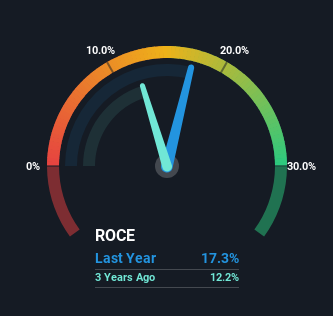Stock Analysis
- India
- /
- Specialty Stores
- /
- NSEI:TBZ
There's Been No Shortage Of Growth Recently For Tribhovandas Bhimji Zaveri's (NSE:TBZ) Returns On Capital

If we want to find a potential multi-bagger, often there are underlying trends that can provide clues. Firstly, we'd want to identify a growing return on capital employed (ROCE) and then alongside that, an ever-increasing base of capital employed. Put simply, these types of businesses are compounding machines, meaning they are continually reinvesting their earnings at ever-higher rates of return. So when we looked at Tribhovandas Bhimji Zaveri (NSE:TBZ) and its trend of ROCE, we really liked what we saw.
Return On Capital Employed (ROCE): What Is It?
For those who don't know, ROCE is a measure of a company's yearly pre-tax profit (its return), relative to the capital employed in the business. To calculate this metric for Tribhovandas Bhimji Zaveri, this is the formula:
Return on Capital Employed = Earnings Before Interest and Tax (EBIT) ÷ (Total Assets - Current Liabilities)
0.17 = ₹1.1b ÷ (₹14b - ₹7.9b) (Based on the trailing twelve months to September 2023).
So, Tribhovandas Bhimji Zaveri has an ROCE of 17%. By itself that's a normal return on capital and it's in line with the industry's average returns of 17%.
View our latest analysis for Tribhovandas Bhimji Zaveri

While the past is not representative of the future, it can be helpful to know how a company has performed historically, which is why we have this chart above. If you'd like to look at how Tribhovandas Bhimji Zaveri has performed in the past in other metrics, you can view this free graph of Tribhovandas Bhimji Zaveri's past earnings, revenue and cash flow.
So How Is Tribhovandas Bhimji Zaveri's ROCE Trending?
The trends we've noticed at Tribhovandas Bhimji Zaveri are quite reassuring. The numbers show that in the last five years, the returns generated on capital employed have grown considerably to 17%. Basically the business is earning more per dollar of capital invested and in addition to that, 34% more capital is being employed now too. This can indicate that there's plenty of opportunities to invest capital internally and at ever higher rates, a combination that's common among multi-baggers.
On a separate but related note, it's important to know that Tribhovandas Bhimji Zaveri has a current liabilities to total assets ratio of 55%, which we'd consider pretty high. This effectively means that suppliers (or short-term creditors) are funding a large portion of the business, so just be aware that this can introduce some elements of risk. Ideally we'd like to see this reduce as that would mean fewer obligations bearing risks.
Our Take On Tribhovandas Bhimji Zaveri's ROCE
A company that is growing its returns on capital and can consistently reinvest in itself is a highly sought after trait, and that's what Tribhovandas Bhimji Zaveri has. Since the stock has returned a solid 94% to shareholders over the last five years, it's fair to say investors are beginning to recognize these changes. So given the stock has proven it has promising trends, it's worth researching the company further to see if these trends are likely to persist.
If you want to know some of the risks facing Tribhovandas Bhimji Zaveri we've found 3 warning signs (1 shouldn't be ignored!) that you should be aware of before investing here.
While Tribhovandas Bhimji Zaveri isn't earning the highest return, check out this free list of companies that are earning high returns on equity with solid balance sheets.
Valuation is complex, but we're helping make it simple.
Find out whether Tribhovandas Bhimji Zaveri is potentially over or undervalued by checking out our comprehensive analysis, which includes fair value estimates, risks and warnings, dividends, insider transactions and financial health.
View the Free AnalysisHave feedback on this article? Concerned about the content? Get in touch with us directly. Alternatively, email editorial-team (at) simplywallst.com.
This article by Simply Wall St is general in nature. We provide commentary based on historical data and analyst forecasts only using an unbiased methodology and our articles are not intended to be financial advice. It does not constitute a recommendation to buy or sell any stock, and does not take account of your objectives, or your financial situation. We aim to bring you long-term focused analysis driven by fundamental data. Note that our analysis may not factor in the latest price-sensitive company announcements or qualitative material. Simply Wall St has no position in any stocks mentioned.
About NSEI:TBZ
Tribhovandas Bhimji Zaveri
Tribhovandas Bhimji Zaveri Limited designs, manufactures, retails, and sells jewelry primarily in India.
Solid track record average dividend payer.

